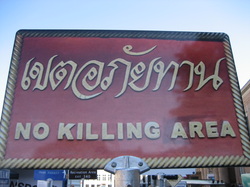
So, with this awareness, about five years ago I started working on the topic. This happened quite by accident. In @, I won an award to be a Visiting Scholar at the Russell Sage Foundation and the project that I intended on engaging in concerning contention in America fell apart as some of the people working with me at the time had to withdraw. In this space, I then asked an interesting question: what was worth researching? After a few weeks (looking through old notes, reading a few books that I had put off and walking through Central Park), I came up with stopping mass violence. What could be done to stop state-sponsored mass killing after it was underway? This was one of the big concerns after the Holocaust and the "Never Again" campaign.
Topic in hand, I then set out to read what had been written and quickly realized that despite a wealth of historical material on individual cases, we were not really clear on what worked in large part because the question had not been asked or examined explicitly. Indeed, at that time mostly every one that studied the termination of conflict and violence was focused on civil war as if that was the only game in town. I had been aided in my thinking by a new project by Alex DeWaal at the SSRC on "How Genocides End". This webpage presented some insights into what might be involved but they did not engage in any rigorous assessments of what worked. They did call for some attention to this topic. Shortly after this I found work by Erik Melander on preventing mass killings before they get started and drawing upon some earlier collaborative work then Courtenay Conrad and Will Moore, came out with a piece on ending torture.
What did I do? Well, initially I tried to find out what data existed. There were a few databases around: e.g., Rudy Rummel's list of "democides" (i.e., genocides and politicides) put together. I had never seen anyone use the source however until Easterly and it was not quite clear how the source material was used to put together the database. There was Barbara Harff and Ted Gurr's list of genocides and politicides which got taken over by the State Failure /Political Instability Task Force (SF/PITF). While this had been used by more scholars than Rummel's data, I again had some questions. For example, it was not clear what source material was used (differing from Rummel's extensive listing) to build the database. Questions aside, I decided to use the Harff/Gurr/SF/PITF data.
I began with what I thought was a simple exercise but one that took more time than I wanted. After hiring a student, finding a source to code all information from (Keesings Contemporary Archive) which was available for all countries from 1950 to the present), working out the coding protocol, coding the material and then recoding when we did not believe the results, we attempted to ascertain how each of the cases in the identified Harff/Gurr/SF/PITF data ended.
Thinking about the subject of termination was pretty interesting because it is clear that these events could end in a wide variety of ways:
The codes:
1) the relevant government (the perpetrators) succeeds in killing off all those targeted
2) the government succeeds in killing off enough of those targeted
3) those targeted leave, eliminating the capacity of the government to continue
4) those targeted receive some type of cover/protection, eliminating the capacity of the government to continue
5) the government cannot continue because of a change in will, resources and/or both
6) the government is blocked by intervention and cannot continue
7) the government changes its strategy of engagement with the targeted community away from violence to something else
8) the government stops because of increased scrutiny/criticism
9) the government stops because of threatened/imposed sanctions
10) The government is forced out of power
The variation is important because discussions of interventions really compel us to think about #6, 8 and 9 but the others are just as possible. Several of them are pretty grim such as #1 and 2 whereas others are kind of sneaky such as #7. It is crucial to differentiate between the strategies however because if we only examine one without considering the others, then we could improperly understand what is taking place. The results from this analysis are provided below.
| genocidecoding_results.xls |
So, I looked at these results and then looked some more. I never quite figured out what to do with these results. I ended more confused about the topic than at the beginning. It was useful to begin my analyses here though. At least that is my conclusion now. I was happy to begin my inquiry into ending state sponsored political violence. This is especially the case when I keep seeing publication after publication coming out on other, somewhat lesser forms of violent action.
As Camus once commented "All I ask is that, in the middle of a murderous world, we agree to reflect on murder and to make a choice"
We this last statement in mind, I announce that this is the first installation of a project i am now calling ENDKILL. Each week I will be moving forward my discussion of how to end state sponsored mass killing. Let's see where a year of sustained effort can take us.
 RSS Feed
RSS Feed
